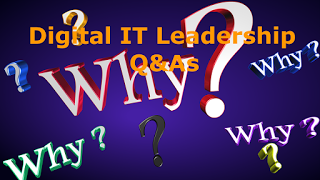The New Book “Digital IT - 100 Q&As” Chapter 1 Introduction Digital IT Leadership Q&As
 Due to the abundance of information and omnipresence of technologies, nowadays, the CIO is not just leveraging IT to keep the lights on, but managing information to ensure the right people getting the right information at the right time to make the right decisions. Digital CIOs have to wear multiple hats and play a different role in the information-abundant organizations today. So, how can IT leaders master the complexity of the digital CIO-plus role in order to lead effortlessly?
Due to the abundance of information and omnipresence of technologies, nowadays, the CIO is not just leveraging IT to keep the lights on, but managing information to ensure the right people getting the right information at the right time to make the right decisions. Digital CIOs have to wear multiple hats and play a different role in the information-abundant organizations today. So, how can IT leaders master the complexity of the digital CIO-plus role in order to lead effortlessly?
Where do CIOs come from: Compare to the other executive positions, the CIO position has a shorter history, but a more dynamic role to play due to the continuous changes of information and technology. The digital trend is that more and more CIOs have diversified experiences and colorful background, from stereotypical to atypical, from operation-driven to strategy-oriented, from the tactical IT manager type to entrepreneurial digital leader style. Most successful CIOs have a good balance of technology and business. It doesn’t matter where the CIO comes from as long as she understands the mission, to drive the business growth and improve IT maturity. Whether you hire an internal CIO or an external Cio depends on your perspective of IT strategy which is an integral part of business strategy. IT depends on where the organization sees IT and the direction that the organization needs to head toward. It depends on what the organizational leaders see as their most important problems and opportunity, and the characteristics of the IT leader that is required to pull it off. Ultimately, the CIO’s success is about vision, leadership, business acumen, creativity & innovation, strategic planning, strong interpersonal communication skills, team-building, intrapreneurship, passion, commitment, and energy.
Is the digital CIO a technologist or a business leader: Due to the changing nature of technology, the CIO role continue to be shaken up, refined, reinvented and re-energized. A digital CIO needs to be a business leader first, technology leader second, and as a result of that attitude and belief, they align better with the needs of the business. But they have to understand the technology and have a sharp mind to leverage business initiatives in artful design via leveraging the latest digital technologies. There are many good business leaders who failed because they didn’t understand the technology or good technologist are not effective leaders because they didn’t have cognizance of the business. IT leaders would not be effective to lead technology-savvy IT staffs if they had little understanding of the technology they are responsible for. The modern CIO must have a balance of technology and business knowledge. It is the hard role with a slippery slope to balance them both successfully, but that is why it is an increasingly critical senior leadership role to make a cross-functional influence.
 What are key differentiators between average and great CIO leadership: Every top digital leader needs to be the change leader due to the “VUCA” characteristics of the digital age. There is a distinct difference between a great CIO and an average CIO in terms of identifying and implementing competitive advantages and being a great leader. The greatness of CIOs depends on how confident they can convey the vision and be humble to learn from others. To be truly great, you have to be confident in your abilities, and be confident to help seek out talent better than themselves at specific activities in specific domains to help make positive changes to the company. It’s about having problem-solving capabilities and skills to invent new ways to create or management information effectively and drive business growth. The key to being “great” is possessing, or working towards developing leadership capabilities and running a high-effective and high-innovative IT organization.
What are key differentiators between average and great CIO leadership: Every top digital leader needs to be the change leader due to the “VUCA” characteristics of the digital age. There is a distinct difference between a great CIO and an average CIO in terms of identifying and implementing competitive advantages and being a great leader. The greatness of CIOs depends on how confident they can convey the vision and be humble to learn from others. To be truly great, you have to be confident in your abilities, and be confident to help seek out talent better than themselves at specific activities in specific domains to help make positive changes to the company. It’s about having problem-solving capabilities and skills to invent new ways to create or management information effectively and drive business growth. The key to being “great” is possessing, or working towards developing leadership capabilities and running a high-effective and high-innovative IT organization.
Digital is dynamic and complex. Making IT digital transformation is not an overnight sensation, but taking a systematic approach. Effective IT management means understanding every island of the operation and every workflow process thoroughly. And a series of healthy debates about IT leadership enable the comprehensive understanding of the art and science of CIO leadership and master the complexity of the role and lead digital transformation seamlessly.
Follow us at: @Pearl_Zhu
Published on April 12, 2017 22:01
No comments have been added yet.



